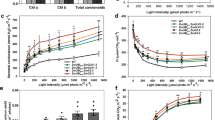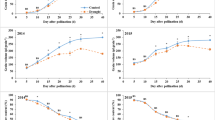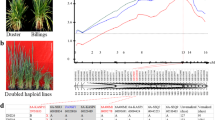Abstract
The elongation of photosynthesis, or functional staygreen, represents a feasible strategy to propel metabolite flux towards cereal kernels. However, achieving this goal remains a challenge in food crops. Here we report the cloning of wheat CO2 assimilation and kernel enhanced 2 (cake2), the mechanism underlying the photosynthesis advantages and natural alleles amenable to breeding elite varieties. A premature stop mutation in the A-genome copy of the ASPARTIC PROTEASE 1 (APP-A1) gene increased the photosynthesis rate and yield. APP1 bound and degraded PsbO, the protective extrinsic member of photosystem II critical for increasing photosynthesis and yield. Furthermore, a natural polymorphism of the APP-A1 gene in common wheat reduced APP-A1’s activity and promoted photosynthesis and grain size and weight. This work demonstrates that the modification of APP1 increases photosynthesis, grain size and yield potentials. The genetic resources could propel photosynthesis and high-yield potentials in elite varieties of tetraploid and hexaploid wheat.
This is a preview of subscription content, access via your institution
Access options
Access Nature and 54 other Nature Portfolio journals
Get Nature+, our best-value online-access subscription
$29.99 / 30 days
cancel any time
Subscribe to this journal
Receive 12 digital issues and online access to articles
$119.00 per year
only $9.92 per issue
Buy this article
- Purchase on Springer Link
- Instant access to full article PDF
Prices may be subject to local taxes which are calculated during checkout






Similar content being viewed by others
Data availability
We deposited the raw sequencing data in the Gene Expression Omnibus Database under the accession code PRJNA861409. Correspondence and requests for other related information or materials should be addressed to the corresponding author. Source data are provided with this paper.
References
Bailey-Serres, J., Parker, J. E., Ainsworth, E. A., Oldroyd, G. E. D. & Schroeder, J. I. Genetic strategies for improving crop yields. Nature 575, 109–118 (2019).
Batista-Silva, W. et al. Engineering improved photosynthesis in the era of synthetic biology. Plant Commun. 1, 100032 (2020).
Singh, J. et al. Enhancing C3 photosynthesis: an outlook on feasible interventions for crop improvement. Plant Biotechnol. J. 12, 1217–1230 (2014).
Ort, D. R. et al. Redesigning photosynthesis to sustainably meet global food and bioenergy demand. Proc. Natl Acad. Sci. USA 112, 8529–8536 (2015).
Slattery, R. A. & Ort, D. R. Perspectives on improving light distribution and light use efficiency in crop canopies. Plant Physiol. 185, 34–48 (2021).
Cavanagh, A. P., South, P. F., Bernacchi, C. J. & Ort, D. R. Alternative pathway to photorespiration protects growth and productivity at elevated temperatures in a model crop. Plant Biotechnol. J. 20, 711–721 (2022).
Murchie, E. H. & Niyogi, K. K. Manipulation of photoprotection to improve plant photosynthesis. Plant Physiol. 155, 86–92 (2011).
Sokolov, V. A. On a possible way to increase the efficiency of photosynthesis. Dokl. Biochem. Biophys. 491, 98–100 (2020).
Taylor, S. H. et al. Faster than expected Rubisco deactivation in shade reduces cowpea photosynthetic potential in variable light conditions. Nat. Plants 8, 118–124 (2022).
Yoon, D.-K. et al. Transgenic rice overproducing Rubisco exhibits increased yields with improved nitrogen-use efficiency in an experimental paddy field. Nat. Food 1, 134–139 (2020).
Chen, J. et al. Genotypic variation in the grain photosynthetic contribution to grain filling in rice. J. Plant Physiol. 253, 153269 (2020).
Sanchez-Bragado, R. et al. New avenues for increasing yield and stability in C3 cereals: exploring ear photosynthesis. Curr. Opin. Plant Biol. 56, 223–234 (2020).
Balazadeh, S. Stay-green not always stays green. Mol. Plant 7, 1264–1266 (2014).
Khan, H. A., Nakamura, Y., Furbank, R. T. & Evans, J. R. Effect of leaf temperature on the estimation of photosynthetic and other traits of wheat leaves from hyperspectral reflectance. J. Exp. Bot. 72, 1271–1281 (2021).
Joshi, S. et al. Improved wheat growth and yield by delayed leaf senescence using developmentally regulated expression of a cytokinin biosynthesis gene. Front. Plant Sci. 10, 1285 (2019).
Lucht, J. M. Public acceptance of plant biotechnology and GM crops. Viruses 7, 4254–4281 (2015).
Stirbet, A., Lazár, D., Guo, Y. & Govindjee, G. Photosynthesis: basics, history and modelling. Ann. Bot. 126, 511–537 (2020).
Kuchel, H., Williams, K. J., Langridge, P., Eagles, H. A. & Jefferies, S. P. Genetic dissection of grain yield in bread wheat. I. QTL analysis. Theor. Appl. Genet. 115, 1029–1041 (2007).
Wang, C. Y. et al. Isolation of wheat mutants with higher grain phenolics to enhance anti-oxidant potential. Food Chem. 303, 125363 (2020).
Ramírez-González, R. H. et al. The transcriptional landscape of polyploid wheat. Science 361, eaar6089 (2018).
Krasileva, K. V. et al. Uncovering hidden variation in polyploid wheat. Proc. Natl Acad. Sci. USA 114, E913–E921 (2017).
Pigolev, A. V. & Klimov, V. V. The green alga Chlamydomonas reinhardtii as a tool for in vivo study of site-directed mutations in PsbO protein of photosystem II. Biochem. (Mosc.) 80, 662–673 (2015).
Wang, S. et al. YR36/WKS1-mediated phosphorylation of PsbO, an extrinsic member of photosystem II, inhibits photosynthesis and confers stripe rust resistance in wheat. Mol. Plant 12, 1639–1650 (2019).
Lupton, F. G. H. Translocation of photosynthetic assimilates in wheat. Ann. Appl. Biol. 57, 355–364 (1966).
Nass, H. G. & Reister, B. Grain filling period and grain yield relationships in spring wheat. Can. J. Plant Sci. 55, 673–678 (1975).
Gebeyehou, G., Knott, D. R. & Baker, R. J. Rate and duration of grain filling in durum wheat cultivars. Crop Sci. 22, 337–340 (1982).
Talbert, L. E., Lanning, S. P., Murphy, R. L. & Martin, J. M. Grain fill duration in twelve hard red spring wheat crosses. Crop Sci. 41, 1390–1395 (2001).
Cook, J. P. et al. Genetic analysis of stay-green, yield, and agronomic traits in spring wheat. Crop Sci. 61, 383–395 (2021).
Chapman, E. A., Orford, S., Lage, J. & Griffiths, S. Delaying or delivering: identification of novel NAM-1 alleles that delay senescence to extend wheat grain fill duration. J. Exp. Bot. 72, 7710–7728 (2021).
Araus, J. L., Sanchez-Bragado, R. & Vicente, R. Improving crop yield and resilience through optimization of photosynthesis: panacea or pipe dream. J. Exp. Bot. 72, 3936–3955 (2021).
Neghliz, H., Cochard, H., Brunel, N. & Martre, P. Ear rachis xylem occlusion and associated loss in hydraulic conductance coincide with the end of grain filling for wheat. Front. Plant Sci. 7, 920 (2016).
IWGSC. Shifting the limits in wheat research and breeding using a fully annotated reference genome. Science 361, eaar7191 (2018).
Pont, C. et al. Tracing the ancestry of modern bread wheats. Nat. Genet. 51, 905–911 (2019).
Horton, P., Long, S. P., Smith, P., Banwart, S. A. & Beerling, D. J. Technologies to deliver food and climate security through agriculture. Nat. Plants 7, 250–255 (2021).
Stitt, M. Progress in understanding and engineering primary plant metabolism. Curr. Opin. Biotechnol. 24, 229–238 (2013).
Tanaka, M. et al. Photosynthetic enhancement, lifespan extension, and leaf area enlargement in flag leaves increased the yield of transgenic rice plants overproducing Rubisco under sufficient N fertilization. Rice 15, 10 (2022).
Zhang, X. et al. TaCol-B5 modifies spike architecture and enhances grain yield in wheat. Science 376, 180–183 (2022).
Maccaferri, M. et al. Durum wheat genome highlights past domestication signatures and future improvement targets. Nat. Genet. 51, 885–895 (2019).
Liu, J. et al. Shaping polyploid wheat for success: origins, domestication, and the genetic improvement of agronomic traits. J. Integr. Plant Biol. 64, 536–563 (2022).
Uauy, C. et al. A modified TILLING approach to detect induced mutations in tetraploid and hexaploid wheat. BMC Plant Biol. 9, 115 (2009).
Guo, W. et al. Origin and adaptation to high altitude of Tibetan semi-wild wheat. Nat. Commun. 11, 5085 (2020).
Wang, W. et al. SnpHub: an easy-to-set-up web server framework for exploring large-scale genomic variation data in the post-genomic era with applications in wheat. Gigascience 9, giaa060 (2020).
Zhou, Y. et al. Triticum population sequencing provides insights into wheat adaptation. Nat. Genet. 52, 1412–1422 (2020).
Hao, C. et al. Resequencing of 145 landmark cultivars reveals asymmetric sub-genome selection and strong founder genotype effects on wheat breeding in China. Mol. Plant 13, 1733–1751 (2020).
Li, H. A statistical framework for SNP calling, mutation discovery, association mapping and population genetical parameter estimation from sequencing data. Bioinformatics 27, 2987–2993 (2011).
Wang, L., Feng, Z., Wang, X. & Zhang, X. DEGseq: an R package for identifying differentially expressed genes from RNA-seq data. Bioinformatics 26, 136–138 (2010).
Gou, J. Y., Yu, X. H. & Liu, C. J. A hydroxycinnamoyltransferase responsible for synthesizing suberin aromatics in Arabidopsis. Proc. Natl Acad. Sci. USA 106, 18855–18860 (2009).
Moyet, L., Salvi, D., Tomizioli, M., Seigneurin-Berny, D. & Rolland, N. Preparation of membrane fractions (envelope, thylakoids, grana, and stroma lamellae) from Arabidopsis chloroplasts for quantitative proteomic investigations and other studies. Methods Mol. Biol. 1696, 117–136 (2018).
Curtis, M. D. & Grossniklaus, U. A gateway cloning vector set for high-throughput functional analysis of genes in planta. Plant Physiol. 133, 462–469 (2003).
Gou, J. Y. et al. Wheat stripe rust resistance protein WKS1 reduces the ability of the thylakoid-associated ascorbate peroxidase to detoxify reactive oxygen species. Plant Cell 27, 1755–1770 (2015).
Fujikawa, Y. & Kato, N. Split luciferase complementation assay to study protein–protein interactions in Arabidopsis protoplasts. Plant J. 52, 185–195 (2007).
Lou, Y., Schwender, J. & Shanklin, J. FAD2 and FAD3 desaturases form heterodimers that facilitate metabolic channeling in vivo. J. Biol. Chem. 289, 17996–18007 (2014).
Guex, N. & Peitsch, M. C. SWISS-MODEL and the Swiss-PdbViewer: an environment for comparative protein modeling. Electrophoresis 18, 2714–2723 (1997).
Acknowledgements
This study was supported by the National Key Research and Development Program of China (grant no. 2022YFF1002902) and the National Natural Science Foundation of China (grant no. 31972350). We thank C. Hao, X. Zhang at the Chinese Academy of Agricultural Sciences and Y. Jiao at Peking University for sharing the hexaploid wheat varieties. We thank J. Dubcovsky at the University of California, Davis, for constructive suggestions.
Author information
Authors and Affiliations
Contributions
J.-Y.G. designed the research, interpreted the data and wrote the manuscript. K.-X.N. performed most of the experiments with help from C.-Y.C., M.-Q.Z., Y.-T.G., Y.Y., H.-J.S., G.-L.Z., X.-M.L., Y.-L.G., C.-H.D. and M.-L.W. Z.N. and Q.S. contributed to the discussion and analysis of the data.
Corresponding author
Ethics declarations
Competing interests
The authors declare no competing interests.
Peer review
Peer review information
Nature Plants thanks Lin Li and Thorsten Schnurbusch for their contribution to the peer review of this work.
Additional information
Publisher’s note Springer Nature remains neutral with regard to jurisdictional claims in published maps and institutional affiliations.
Extended data
Extended Data Fig. 1 The phylogenetic analysis and expression patterns of wheat APP gene family.
Note that we extracted the data from GSE12508 in NCBI.
Extended Data Fig. 2 Genotype of the app-B1 mutant and its effect on translation.
a,b, Sequence of the app-B1 gene at the mutation site and its effect on the coding sequence.
Extended Data Fig. 3 The phenotype and agricultural traits of psbo-A1 mutant.
a. Comparison of the endogenous PsbO protein levels in the dysfunction mutants. b, c. Grain sizes of WT and psbo-A1 mutant. Bars= 1 cm. d–f. Phenotypic data of grains from WT and psbo-A1 mutants, including grain length (n = 10), grain width (n = 10), grain thickness (n = 20), 1000-grain weight (n = 15), Grain roundness (n = 4), and Tons/HA (n = 3). Data represented mean ± SD; the two-tailed unpaired Student’s t-test indicates p-values.
Extended Data Fig. 4 The specific enzymatic activity of APP1.
The specific enzymatic activity of APP1 on a synthetic substrate and PsbO. a. The specific enzymatic activity of APP1 on an artificial substrate. n = 4, Data represented mean ± SD, and the two-tailed unpaired Student’s t-test indicates p-values. b. The specific enzymatic activity of APP1 on PsbO.
Extended Data Fig. 5 The gene ontology analysis of differentially expressed genes in app-A1.
a. Venn diagram representation of up-regulated expression genes between the app-A1 backcrossed mutant and WT. b. Venn diagram representation of down-regulated expression genes between the app-A1 backcrossed mutant and WT. c. The APP-A1 expression in app-A1 mutant and WT through RNA-seq. n = 3, Data represented mean ± SD, and the two-tailed unpaired Student’s t-test indicates p-values. d. The PsbO-A1 expression in app-A1 mutant and WT through RNA-seq. n = 3, Data represented mean ± SD, and the two-tailed unpaired Student’s t-test indicates p-values. GO (e) and KEGG (f) analysis in the app-A1 mutant. n = 3.
Supplementary information
Supplementary Information
Supplementary Figs. 1 and 2 and Data 1 and 2.
Source data
Fig. 2
Unprocessed films for Fig. 2.
Fig. 3
Unprocessed films for Fig. 3.
Fig. 4
Unprocessed films for Fig. 4.
Fig. 6
Unprocessed films for Fig. 6.
Extended Data Fig. 3
Unprocessed films for Extended Data Fig. 3.
Extended Data Fig. 4
Unprocessed films for Extended Data Fig. 4.
Fig. 1
Statistical data for Fig. 1.
Fig. 2
Statistical data for Fig. 2.
Fig. 3
Statistical data for Fig. 3.
Fig. 5
Statistical data for Fig. 5.
Fig. 6
Statistical data for Fig. 6.
Extended Data Fig. 1
Statistical data for Extended Data Fig. 1.
Extended Data Fig. 3
Statistical data for Extended Data Fig. 3.
Extended Data Fig. 4
Statistical data for Extended Data Fig. 4.
Extended Data Fig. 5
Statistical data for Extended Data Fig. 5.
Rights and permissions
Springer Nature or its licensor (e.g. a society or other partner) holds exclusive rights to this article under a publishing agreement with the author(s) or other rightsholder(s); author self-archiving of the accepted manuscript version of this article is solely governed by the terms of such publishing agreement and applicable law.
About this article
Cite this article
Niu, KX., Chang, CY., Zhang, MQ. et al. Suppressing ASPARTIC PROTEASE 1 prolongs photosynthesis and increases wheat grain weight. Nat. Plants 9, 965–977 (2023). https://doi.org/10.1038/s41477-023-01432-x
Received:
Accepted:
Published:
Issue Date:
DOI: https://doi.org/10.1038/s41477-023-01432-x



